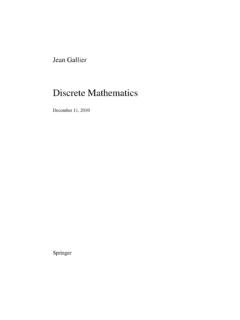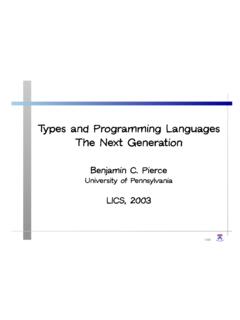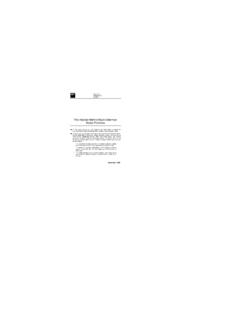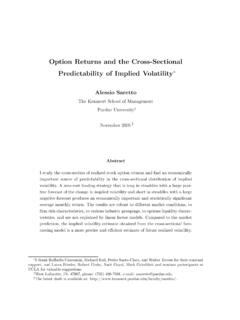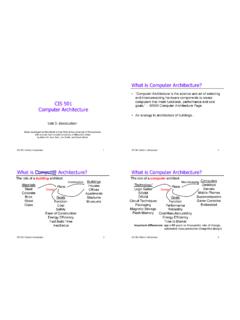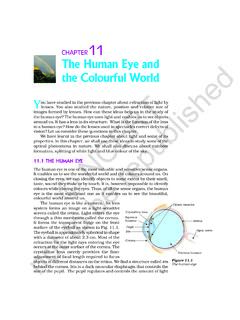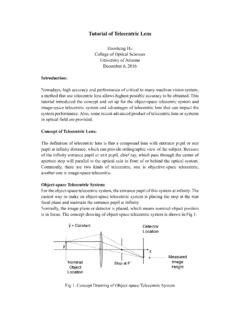Transcription of This Unit: Floating Point Arithmetic
1 CIS371 (Roth/Martin): Floating Point1 CIS 371 Computer Organization and DesignUnit 7: Floating PointCIS371 (Roth/Martin): Floating Point2 This Unit: Floating Point Arithmetic Formats Precision and range IEEE 754 standard Operations Addition and subtraction Multiplication and division Error analysis Error and bias Rounding and truncationCPUMemI/OSystem softwareAppAppAppCIS371 (Roth/Martin): Floating Point3 Readings P+H Chapter and (Roth/Martin): Floating Point4 Floating Point (FP) Numbers Floating Point numbers: numbers in scientific notation Two uses Use I: real numbers (numbers with non-zero fractions) * 10 34 Use II: really big numbers * 108 * 1023 Aside: best not used for currency valuesCIS371 (Roth/Martin): Floating Point5 The Land Before Floating Point Early computers were built for scientific calculations ENIAC: ballistic firing tables.
2 But didn t have primitive Floating Point data types Many embedded chips today lack Floating Point hardware Programmers built scale factors into programs Large constant multiplier turns all FP numbers to integers inputs multiplied by scale factor manually Outputs divided by scale factor manually Sometimes called fixed Point arithmeticCIS371 (Roth/Martin): Floating Point6 The Fixed Width Dilemma Natural Arithmetic has infinite width Infinite number of integers Infinite number of reals Infinitely more reals than integers ( ) Hardware Arithmetic has finite width N ( , 16, 32, 64) Can represent 2N numbers If you could represent 2N integers, which would they be?
3 Easy, the 2N 1 on either size of 0 If you could represent 2N reals, which would they be? 2N reals from 0 to 1, not too useful (Roth/Martin): Floating Point7 Range and Precision Range Distance between largest and smallest representable numbers Want big Precision Distance between two consecutive representable numbers Want small In fixed width, can t have unlimited bothCIS371 (Roth/Martin): Floating Point8 Scientific Notation Scientific notation: good compromise Number [S,F,E] = S * F * 2E S: sign F: significand (fraction) E: exponent Floating Point : binary (decimal) Point has different magnitude+ Sliding window of precision using notion of significant digits Small numbers very precise, many places after decimal Point Big numbers are much less so, not all integers representable But for those instances you don t really care anyway Caveat: all representations are just approximations Sometimes wierdos like or come up+But good enough for most purposesCIS371 (Roth/Martin): Floating Point9 IEEE 754 Standard Precision/Range Single precision: float in C 32-bit: 1-bit sign + 8-bit exponent + 23-bit significand Range: * 10 38 < N < * 1038 Precision.
4 ~7 significant (decimal) digits Used when exact precision is less important ( , 3D games) Double precision: double in C 64-bit: 1-bit sign + 11-bit exponent + 52-bit significand Range: * 10 308 < N < * 10308 Precision: ~15 significant (decimal) digits Used for scientific computations Numbers >10308 don t come up in many calculations 1080 ~ number of atoms in universeCIS371 (Roth/Martin): Floating Point10 How Do Bits Represent Fractions? Sign: 0 or 1 ! easy Exponent: signed integer ! also easy Significand: unsigned fraction ! ?? How do we represent integers? Sums of positive powers of two S-bit unsigned integer A: AS 12S 1 + AS 22S 2 +.
5 + A121 + A020 So how can we represent fractions? Sums of negative powers of two S-bit unsigned fraction A: AS 120 + AS 22 1 + .. + A12 S+2 + A02 S+1 1, 1/2, 1/4, 1/8, 1/16, 1/32, .. More significant bits correspond to larger multipliersCIS371 (Roth/Martin): Floating Point11 Some Examples What is 5 in Floating Point ? Sign: 0 5 = * 22 Significand: = 1*20 + 1*2 2 = 101 0000 0000 0000 0000 0000 Exponent: 2 = 0000 0010 What is in Floating Point ? Sign: 1 = * 20 Significand: = 1*2 1 = 010 0000 0000 0000 0000 0000 Exponent: 0 = 0000 0000 CIS371 (Roth/Martin): Floating Point12 Normalized Numbers Notice 5 is * 22 But isn t it also * 23 and * 24 and.
6 ? With 8-bit exponent, we can have 256 representations of 5 Multiple representations for one number Lead to computational errors Waste bits Solution: choose normal (canonical) form Disallow de-normalized numbers IEEE 754 normal form: coefficient of 20 is 1 Similar to scientific notation: one non-zero digit left of decimal Normalized representation of 5 is * 22 ( = 1*20+1*2-2) * 23 is de-normalized ( = 0*20+1*2-1+ 1*2-3)CIS371 (Roth/Martin): Floating Point13 More About Normalization What is in normalized Floating Point ? Sign: 1 = 1 * 2 1 Significand: 1 = 1*20 = 100 0000 0000 0000 0000 0000 Exponent: -1 = 1111 1111 IEEE754: no need to represent co-efficient of 20 explicitly It s always 1+Buy yourself an extra bit (~1/3 of decimal digit) of precision Yeeha Problem: what about 0?
7 How can we represent 0 if 20 is always implicitly 1?CIS371 (Roth/Martin): Floating Point14 IEEE 754: The Whole Story Exponent: signed integer ! not so fast Exponent represented in excess or bias notation N-bits typically can represent signed numbers from 2N 1 to 2N 1 1 But in IEEE 754, they represent exponents from 2N 1+2 to 2N 1 1 And they represent those as unsigned with an implicit 2N 1 1 added Implicit added quantity is called the bias Actual exponent is E (2N 1 1) Example: single precision (8-bit exponent) Bias is 127, exponent range is 126 to 127 126 is represented as 1 = 0000 0001 127 is represented as 254 = 1111 1110 0 is represented as 127 = 0111 1111 1 is represented as 128 = 1000 0000 CIS371 (Roth/Martin): Floating Point15 IEEE 754.
8 Continued Notice: two exponent bit patterns are unused 0000 0000: represents de-normalized numbers Numbers that have implicit 0 (rather than 1) in 20 Zero is a special kind of de-normalized number+Exponent is all 0s, significand is all 0s (bzero still works) There are both +0 and 0, but they are considered the same Also represent numbers smaller than smallest normalized numbers 1111 1111: represents infinity and NaN infinities have 0s in the significand NaNs do notCIS371 (Roth/Martin): Floating Point16 IEEE 754: infinity and beyond What are infinity and NaN used for? To allow operations to proceed past overflow/underflow situations Overflow: operation yields exponent greater than 2N 1 1 Underflow: operation yields exponent less than 2N 1+2 IEEE 754 defines operations on infinity and NaN N / 0 = infinity N / infinity = 0 0 / 0 = NaN infinity / infinity = NaN infinity infinity = NaN Anything and NaN = NaNCIS371 (Roth/Martin): Floating Point17 IEEE 754.
9 Final Format Biased exponent Normalized significand Exponent more significant than significand Helps comparing FP numbers Exponent bias notation helps there too Every computer since about 1980 supports this standard Makes code portable (at the source level at least) Makes hardware faster (stand on each other s shoulders)expsignificandCIS371 (Roth/Martin): Floating Point18 Floating Point Arithmetic We will look at Addition/subtraction Multiplication/division Implementation Basically, integer Arithmetic on significand and exponent Using integer ALUs Plus extra hardware for normalization To help us here, look at toy quarter precision format 8 bits: 1-bit sign + 3-bit exponent + 4-bit significand Bias is 3 CIS371 (Roth/Martin): Floating Point19FP Addition Assume A represented as bit pattern [SA, EA, FA] B represented as bit pattern [SB, EB, FB] What is the bit pattern for A+B [SA+B, EA+B, FA+B]?
10 [SA+SB, EA+EB, FA+FB]? Of course not So what is it then?CIS371 (Roth/Martin): Floating Point20FP Addition Decimal Example Let s look at a decimal example first: + *101 + *10-1 Step I: align exponents (if necessary) Temporarily de-normalize one with smaller exponent Add 2 to exponent ! shift significand right by 2 * 10-1 ! *101 Step II: add significands Remember overflow, it isn t treated like integer overflow *101 + *101 ! *101 Step III: normalize result Shift significand right by 1 add 1 to exponent *101 ! *102 CIS371 (Roth/Martin): Floating Point21FP Addition Quarter Example Now a binary quarter example: + = *22 = 0 101 11110 = 1*20+1*2-1+1*2-2+1*2-3 = 1*2-1 = 0 010 10000 Step I: align exponents (if necessary) 0 010 10000 !
